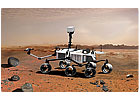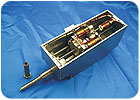

As part of the 2009 Mars Science Laboratory mission, veteran space subcontractor Honeybee Robotics Spacecraft and Mechanisms Design Co. (New York) has built a new “Mini-Corer” that the company hopes will be chosen to take rock samples for analysis on board the 2009 Rover. Similar to the Rock Abrasion Tool Honeybee built for the Rover that went to Mars in 2003, the Mini-Corer must be able to withstand the extreme cold of space, the vibration and G-forces it will experience during liftoff, and the dust and grime it will encounter on Mars.
To protect the corer’s mechanisms, Honeybee encased the entire system in a sealed, shoebox-sized enclosure made out of aluminum and beryllium. Inside this box is another, smaller box-about the size of a man’s fist-which slides back and forth inside the larger box and contains the corer’s motors, gears and drill shaft.
Central to the success of the mechanism is a pair of SMS10WUU double-wide linear bearings from linear motion manufacturer NB Corp. of America (Wood Dale, IL). When the Mini-Corer drills into rock, the big box doesn’t move at all. Instead, the “guts” inside the box push the drill shaft and a 2-inch coring bit into the rock. As part of this process, the inside box moves up and down about 6 inches on its NB slides.
Honeybee chose the slides because of their light weight and rigidity. The company went with double-wide linear bearings, because they provide more stiffness than would be possible using standard-width bushings.
“When we created the Mini-Corer, our engineers started researching places that would give us the highest quality precision slide rails,” says Honeybee systems engineer Mike Maksymuk. “The forces and torques that the…double-wide linear bearings can handle were enough that we didn’t need to look further. That’s because, being a double linear slide, it gives us more distributed load.
“Imagine coming down on a rock with your drill moving forward without cutting rock perpendicular to its surface. That’s going to put a lot of side loads back into the tool.... If the drill shaft flexes too much, it will not be able to drill the rock efficiently. We needed something really rigid to prevent the tool from flexing.”
To date, an engineering model of the Mini-Corer has been put to work in NASA’s field-test Rover, FIDO, to facilitate basic mission operations testing. The model currently resides at NASA’s Jet Propulsion Laboratory in Pasadena, CA, patiently waiting for liftoff.
For more on automation and linear motion, call 800-521-2045 or visitwww.nbcorporation.com.


